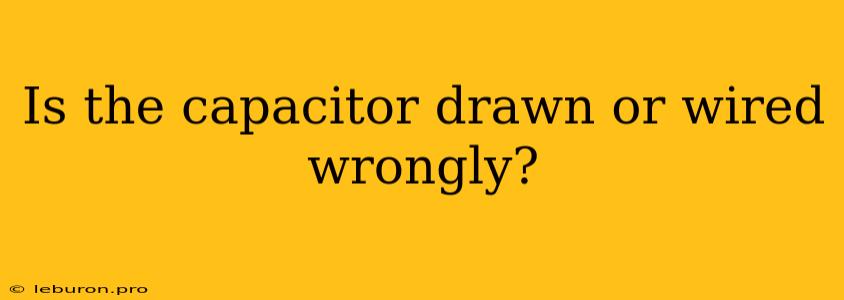Capacitors are essential components in electronic circuits, playing a crucial role in filtering, smoothing, and storing energy. While their function is vital, it's equally important to ensure they are wired correctly to avoid circuit malfunction or even damage. This article will delve into the common misconceptions and potential problems that arise when capacitors are incorrectly drawn or wired in a circuit, providing insights on how to identify and rectify these issues.
Understanding Capacitor Functionality
Before addressing potential errors, it's essential to grasp the fundamental principles behind capacitor operation. A capacitor essentially stores electrical energy in an electric field established between two conductive plates separated by a non-conductive material known as a dielectric. When a voltage is applied across the capacitor, the electric field builds up, storing energy.
Polarized vs. Non-Polarized Capacitors
A key aspect to consider is whether the capacitor is polarized or non-polarized. Polarized capacitors have a defined positive (+) and negative (-) terminal, which must be connected correctly in the circuit. This is because they utilize a specific type of dielectric that can be damaged by reverse polarity. Non-polarized capacitors, on the other hand, can be connected without regard to polarity.
Common Mistakes in Capacitor Drawing and Wiring
Several common errors can occur in the drawing or wiring of capacitors, potentially leading to circuit problems. These mistakes include:
Incorrect Terminal Placement
The most straightforward mistake is placing the capacitor terminals in the wrong position on the circuit diagram. This can lead to confusion during circuit assembly and might even cause circuit malfunction.
Reversing Polarity in Polarized Capacitors
This is a critical error that can damage the capacitor and potentially the entire circuit. Polarized capacitors are marked with a "+" sign to indicate the positive terminal. Connecting the positive terminal to the negative side of the circuit will reverse the polarity, causing the capacitor to overheat and fail.
Connecting Capacitor Directly to a Power Source
Capacitors are not designed to be connected directly to a power source. This is because they have a relatively low resistance and can draw a large current, potentially damaging the capacitor or the power supply.
Using the Wrong Type of Capacitor
Choosing the wrong type of capacitor for a particular application can lead to poor circuit performance. Factors to consider include voltage rating, capacitance value, and the capacitor's intended purpose (e.g., filtering, smoothing, or energy storage).
Identifying and Correcting Mistakes
Recognizing potential mistakes in capacitor drawings or wiring is crucial. Here are some tips:
Examine the Circuit Diagram Carefully
Thoroughly review the circuit diagram, ensuring the capacitor terminals are placed correctly and the polarity is maintained for polarized capacitors.
Check for Obvious Misconnections
Inspect the physical connections between the capacitor and the rest of the circuit. Look for any loose connections or wires that are connected to the wrong terminals.
Use a Multimeter to Test the Capacitor
A multimeter can be used to test the capacitance value and check for any internal shorts or open circuits.
Review the Capacitor's Datasheet
The datasheet for the capacitor will provide details about its specifications, including its voltage rating, capacitance value, and polarity.
Consequences of Incorrect Wiring
Wiring a capacitor incorrectly can lead to several problems:
Circuit Malfunction
Improper wiring can disrupt the circuit's intended operation. This might result in erratic behavior, unexpected voltage drops, or complete failure.
Capacitor Damage
Connecting a polarized capacitor with reverse polarity will likely cause it to overheat and fail. Even non-polarized capacitors can be damaged if they are subjected to excessive voltage or current.
Fire Hazard
In some cases, faulty wiring can lead to overheating and potential fire hazards. This is especially true for large capacitors or those handling significant power.
Conclusion
Ensuring that capacitors are drawn and wired correctly is essential for the proper operation of electronic circuits. By understanding the fundamental principles of capacitor operation, recognizing potential errors, and implementing careful wiring practices, you can minimize the risk of circuit malfunctions and ensure the longevity of your circuits.
